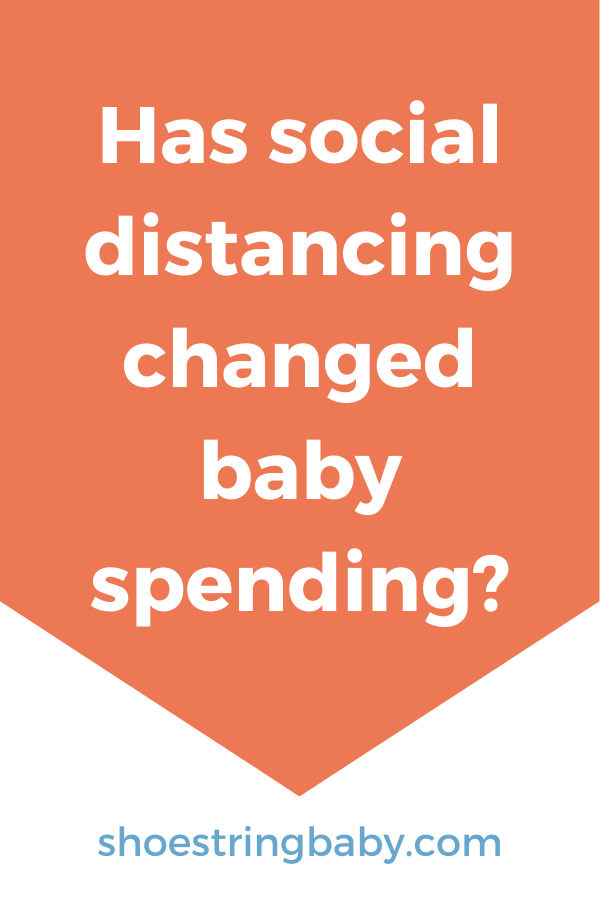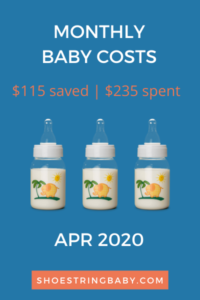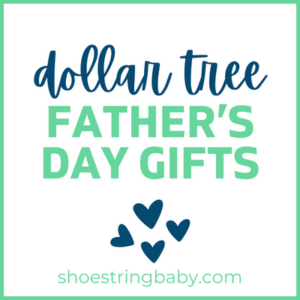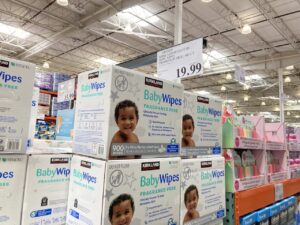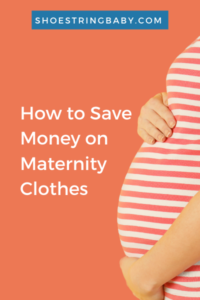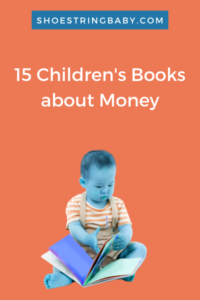Has the Pandemic Changed Baby Spending?
This post may contains affiliate links. As an Amazon Associate, I earn from qualifying purchases. Read the full disclosure here.
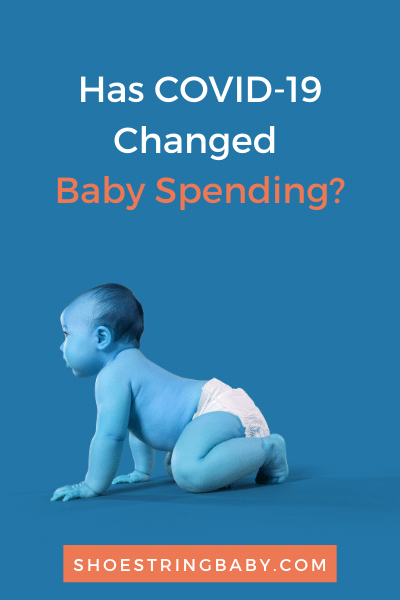
Last week, the U.S. Department of Commerce released data on last month’s retail sales and, not surprisingly, they aren’t pretty.
As the world waits at home for the COVID-19 pandemic to run it’s course, the global economy has ground to a halt. The New York Times repeatedly used the word ‘catastrophic‘ in their reporting on the spending trends.
Yet, details on how the current COVID-19 crisis has changed baby and child-focused spending hasn’t been extensively fleshed out. On the one hand, babies need things like diapers and formula regardless of social distancing. Parents are also desperate to entertain their kids at home all day.
On the other, they quickly outgrow clothes and developmental toys (indeed, toy spending is down). Babies may completely skip items or seasonal clothes by the time quarantining ends, an example of what economists call destroyed demand.
In addition to overall reduced retail spending generally, this type of data can’t tell the qualitative stories of parents trying to buy baby necessities while navigating exposure risk during store trips, varying product availability, people’s hoarding, and economic insecurity and job loss.
What challenges are parents facing keeping their babies diapered and fed? Is spending on baby items increased or decreased in our current COVID-19 world? Are baby basics like wipes and diapers readily available?
surveying parents with infants
Parenting a baby is already a stressful phase of life. How has a pandemic changed the game for parents of infants?
To learn more about recent parents’ lived experiences with COVID-19 and baby spending, I fielded a quick survey on how baby spending has changed with social distancing, factors contributing to those changes, baby product accessibility, and financial challenges of having a baby during a pandemic.
I shared the survey with a private online group for families having babies with similar due dates (thank you subreddit friends!). From that group, 96 individuals who had a baby born in fall 2019 responded. Their babies’ ages ranged from 5 to 8 months, with an average of 5.7 months. Twenty percent of respondents had more than one child.
Before diving into the results, this former academic needs to emphasize that the survey is in no way representative of the wider population. Very likely the people who voluntarily complete a survey in an online group are different from those opting not to complete it.
I also did not collect demographic information to keep the survey as anonymous as possible. As such, these should be seen as snapshots of individual stories instead of statistically generalizable results.
How has cOVID-19 social distancing changed baby spending?
Survey respondents were split between those facing increased baby spending during COVID-19 and those who have decreased their spending. This divided result makes sense given the competing demands on parents currently.
For example, people may simultaneously need to stock up on necessities like diapers while also cutting costs in the face of widespread economic uncertainty. Parents want to entertain their babies as they work at home, while also avoiding non-essential shopping.
Since the start of COVID-19 social distancing, to what extent has your baby/child spending changed?
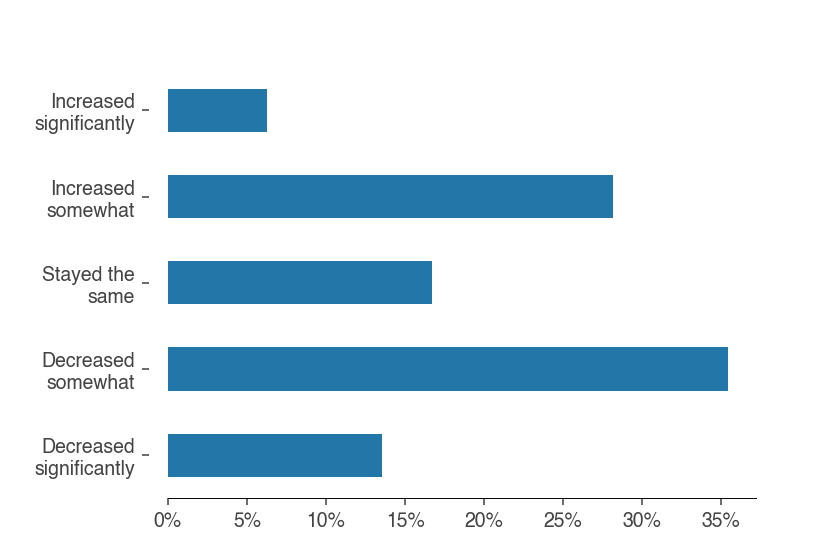
Overall, 49% of responding parents have decreased their baby spending and 34% have increased spending. About a sixth of the respondents have not changed their baby spending habits.
Further broken down by baby product category, spending is generally up in baby necessity categories and down in childcare expenses.
Since the start of COVID-19 social distancing, to what extend has your baby/child spending changed in the following categories:

Families differed on spending on clothes and toys and entertainment. People seem particularly split over toys and entertainment. Thirty seven people reported increased spending while 31 people decreased their spending.
“[The baby] needs more toys to stay entertained and quiet [during work] video calls.”
“Things like toys/clothing don’t seem so vital anymore.”
This likely reflect the differing challenges families are currently navigating. On one hand, parents may need to keep their babies entertained while inside the home all day.
On the other, toys are non-essentials and may be limited as families reduce shopping for budgetary or social responsibility reasons.
Factors Contributing to change in baby spending
To better understand why baby spending has changed for families, respondents were asked to what extent factors like loss of income, shopping frequency, virus exposure concerns, social responsibility and change in childcare related to their reported change.
To what extend have the following contributed to your change in baby/child spending?

In the graph above, respondents were broken apart into the group reporting decreased spending and the group reporting unchanged or increased spending. The biggest factors for both groups were shopping frequency, virus exposure concerns and social responsibility.
“I’m an essential worker, so we haven’t lost income, but I’m really worried about us [or the] baby especially getting sick.”
The survey also allowed individuals to give open ended answers on their top two factors impacting their changed spending behaviors. These qualitative answers were coded and the frequency of reported factors was tabulated.
In the table below, the number reported in the number of respondents who mentioned that factor in their responses.
Open ended question response frequency of two biggest factors contributing to change in baby/child spending.

The qualitative answers fell into 7 main categories and a miscellaneous category. Of the 7, ‘staying home’ and ‘childcare’ were mentioned by 10 respondents each.
“The inability to leave the house has been our biggest factor in reduced spending.”
The biggest category of factors was those related to shopping. Many respondents reported limiting trips to the store and stocking up on supplies during this time.
Interestingly, the second-biggest shopping factor was individuals reporting that they have reduced impulse purchasing by not being in a physical store. Many of those noting a reduction in impulse purchases also mentioned not going to Target specifically as a factor in their changed spending behaviors.
“[I’m] not going to Target and impulse purchasing.”
The next most common category was entertainment and toys. People reported needing entertainment, with some specifically mentioning it being needed while the parent/s worked from home.
The word ‘bored’ or ‘boredom’ was also specifically mentioned by seven individuals. Eight individuals made reference to not having baby or child activities, and seven discussed toys.
Infants change quickly in the first year and can have different developmental needs in the matter of weeks or even days. These factors were grouped in a ‘growing baby’ category and included things like changed feeding and introducing solid food, size changes and desire for new developmental toys.
Perhaps surprisingly, money and job status change were not as frequently mentioned as one would expect given the staggering unemployment numbers.
“We’re blessed to have no change in income yet, but we’re being conservative [..] in case this stretches on and one or both of us is ultimately impacted.”
Individuals did report changing financial priorities, likely as a result of uncertain economic futures. It would be interesting to see how these factors may shift with time, as we are still in the early days of our frozen economies.
Downstream effects of social distancing, such as business closures, are yet to be fully felt. It seems reasonable that more people will face economic hardship in the coming months, and that baby discretionary spending will adjust accordingly.
Baby Product Availability
In addition to financial changes, families are also currently contending with fluctuating availability of baby products. As families report minimizing trips to stores and challenges with ordering baby supplies online with reasonable delivery times, getting ahold of preferred baby products can be difficult.
“[We] need to have more diapers and wipes on hand to limit trips to the store.”
Of those surveyed, 59% reported trouble finding at least one baby item at some point during social distancing.
What baby/child items have you had trouble buying since the start of COVID-19 Social Distancing? (59% of respondents reporting at least one item)
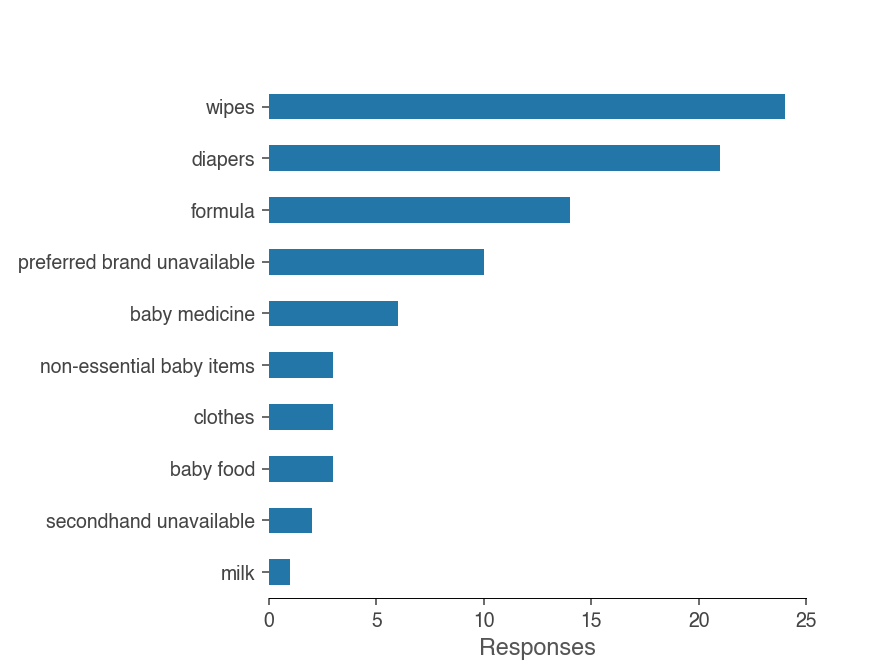
The most commonly reported unavailable item was baby wipes, with 24 families saying that they were unable to get wipes at some point since COVID-19 started. This may reflect people without babies buying wipes when other cleaning and hand sanitizing products have been unavailable.
Twenty-one people also reported difficulty in buying diapers.
Fourteen people said they had trouble finding formula or their preferred brand of formula. Unlike subbing out brands of wipes or diapers, changing baby formula brands may cause discomfort in some babies.
“More thankful than ever for breastfeeding and cloth diapering in this time”
In addition to formula brands, parents also mentioned not being able to find preferred brands of diapers and wipes. A few commented that they weren’t able to select usual cost-savings options like generics, bulk sized or secondhand items.
One parent commented that they had trouble buying milk for an older child. It is a sad juxtaposition that individuals are struggling to find food staples like milk at a time when farms are having to destroy food because of decreased restaurant and school demand (as it is difficult or impossible to pivot supply chains quickly).
biggest Financial Challenges of having a baby – before & after COVID-19
Respondents were asked about their family financial situation in regards to ability to purchase baby/child items currently and prior to COVID-19 social distancing.
They were asked if they could: comfortably afford any baby items, afford baby necessities (e.g. diapers, formula), struggle to afford baby necessities, or unable to afford baby necessities.
This was asked to get a sense of the respondents’ overall family financial situations, and how family financial situations may have changed with social distancing measures.
Comparison of family financial situation around baby/child expenses before and after COVID-19 social distancing.
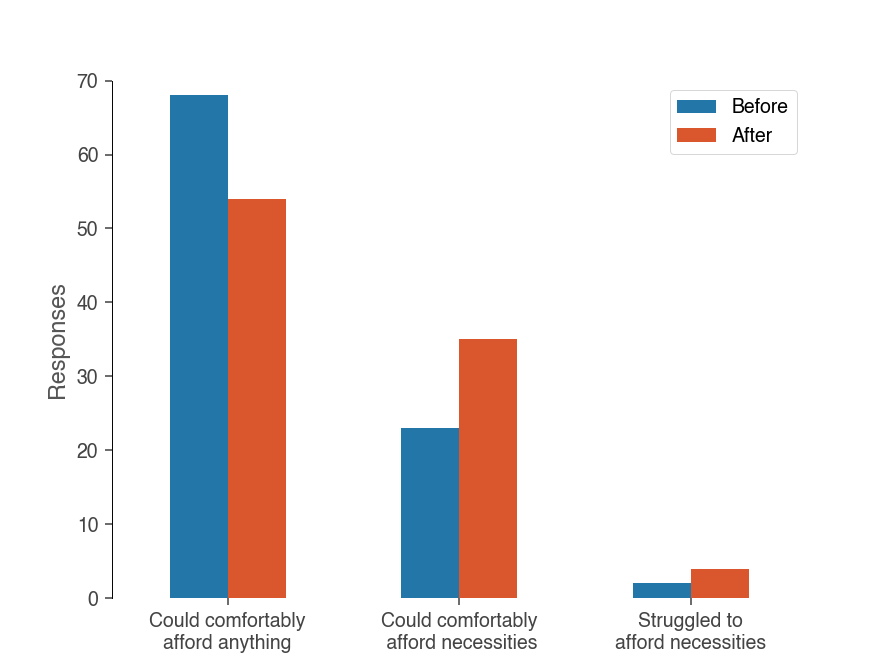
Of the 93 people responding to this question, 78 reported the same family finance situation before and after the novel coronavirus. The majority of respondents could comfortable afford anything for their babies both before social distancing and currently.
Seventeen individuals, just under 20% of respondents, reported a downgraded financial situation.
Fifteen families dropped from ‘comfortably afford anything for baby’ to ‘afford baby necessities,’ and two reported going from affording baby necessities to struggling to afford those necessities. One individual reported an improved financial situation.
For a more nuanced look, respondents were asked an open-ended question about their biggest baby costs or financial challenges before and after social distancing.
Comparison of reported biggest financial challenge or cost faced because of baby/child before and after COVID-19 social distancing (open ended response frequency).

Interestingly, those reporting no baby-related financial challenges jumped about 10% with social distancing.
“We’ve actually SAVED money from not commuting and not driving the baby to activities!”
Concurrently, there was a large drop (21% change) in those reporting daycare costs as the biggest financial burden, which makes sense as daycare centers have been forced to close.
Five people reported no baby-related financial burden now, after having childcare as their biggest baby cost before COVID-19. A handful of parents reported still having to pay for daycare costs even while centers were shut down.
“We’re still paying half tuition for daycare. [..] We are paying a lot (high childcare cost area of the country) and still are both trying to work from home full time with an infant.”
Baby staples like diapering costs, formula and clothing remained mostly steady in the before and after comparisons. Three individuals reported that they were still paying off medical debt from their baby’s delivery last year.
Only two individuals reported income loss as their biggest baby-related post-pandemic financial challenge.
Conclusion
Overall, baby spending during COVID-19 varies across families. Even when faced with similar challenges, such as limiting store trips, some families saw more expenses from stockpiling baby necessities whereas others saw decreases from reduced impulse buying.
One experience shared by over 50 families was difficulty in accessing necessary baby goods such as diapers at some point during social distancing.
In all likelihood, we are in the early days of the economic impact of the COVID-19 pandemic. Many parents are likely to face dynamic and uncertain financial situations that will impact their baby spending in the coming months.
For now though, families with infants could benefit from more reliable access to baby necessities like wipes and formula. Access to non-essentials like toys to keep children content could also help parents trying to juggle work and baby care in the confines of their home.
In this way, the big takeaway of the survey reflects what everyone seems to be struggling with: how to keep living while not endangering yourself or others.
These families with young babies are trying to find the balance between what helps them make it through each day with what helps minimize virus and economic risks for themselves and society at large.

